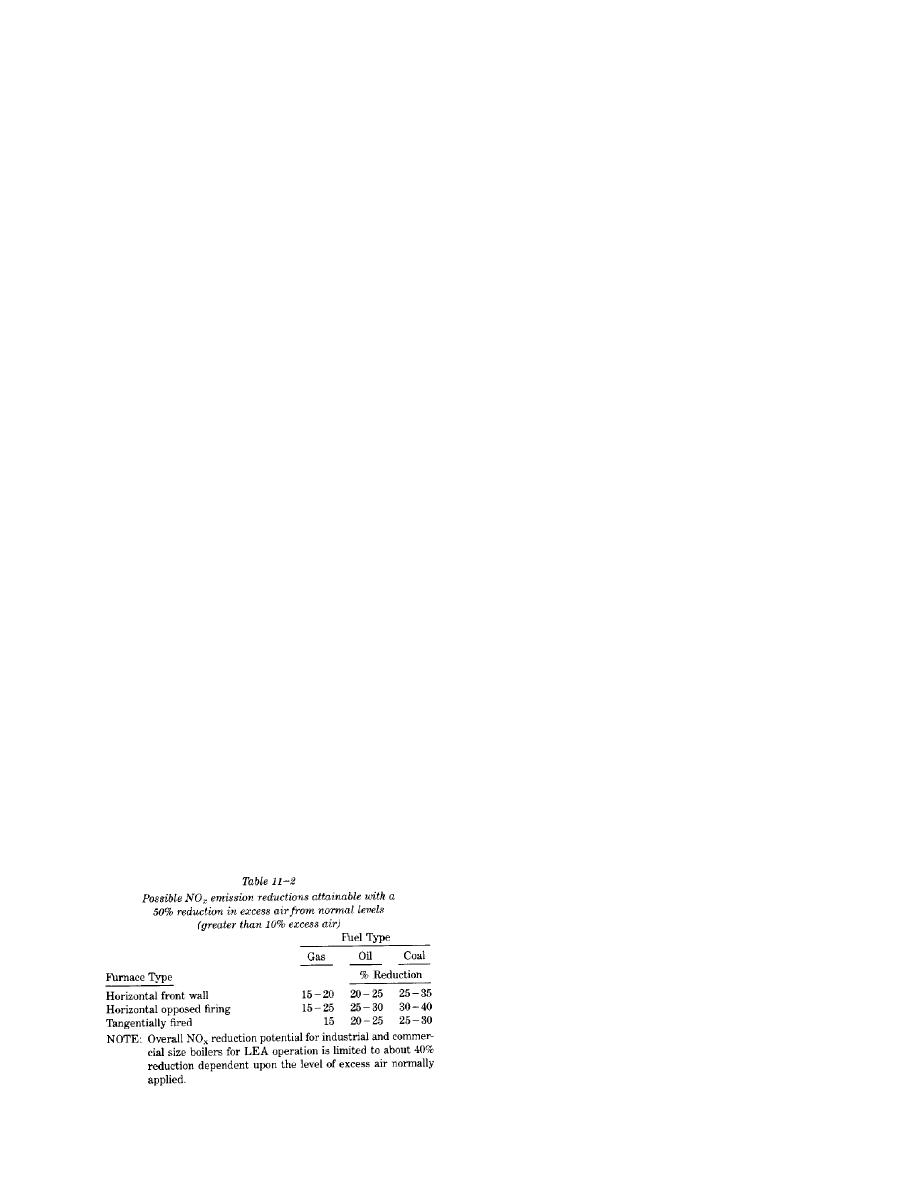
TM 5-815-1/AFR 19-6
(2) The successful application of LEA firing to
in NO2 is attainable burning gas fuels because
they contain only a small amount of fuel-
any unit requires a combustion control system
bound nitrogen. Fuel-bound nitrogen
to regulate and monitor the exact
conversion does not appear to be affected by
proportioning of fuel and air. For pulverized
furnace temperatures, which accounts for the
coal fired boilers, this may mean the
lower NOx reductions obtained with coal and
additional expense of installing uniform
oil firing. Some units such as tangentially
distribution systems for the coal and air
fired boilers show as much as 25 percent
mixture.
decrease in NOx emissions with a 25 percent
(3) Low excess air firing is a desirable method of
load reduction while burning pulverized coal.
reducing NOx emission because it can also
(2) Although no capital costs are involved in load
improve boiler efficiency by reducing the
reduction, it is sometimes undesirable to
amount of heat lost up the stack. Con-
reduce load because it may reduce steam
sequently, a reduction in fuel combustion will
cycle efficiency.
sometimes accompany LEA firing.
c. Low excess air firing (LEA). In order to complete
d. Low excess air firing with load reduction. NOx
the combustion of a fuel, a certain amount of excess air
emissions may be reduced by implementing a load
is necessary beyond the stoichiometric requirements.
reduction while operating under low excess air condi-
The more efficient the burners are in misting, the
tions (table 11-2). This combined technique may be
smaller will be the excess air requirement. A minimum
desirable in an installation where NOx emissions are
amount of excess air is needed in any system to limit
extremely high because of poor air distribution and the
the production of smoke or unburned combustibles;
resultant inefficient operation of combustible equip-
but larger amounts may be needed to maintain steam
ment. A load reduction may permit more accurate con-
temperature to prevent refractory damage; to complete
trol of the combustion equipment and allow reduction
combustion when air supply between burners is unbal-
of excess air requirements to a minimum value. NOx
anced; and to compensate for instrument lag between
reduction achieved by simultaneous implementation of
operational changes. Practical minimums of excess air
load reduction and LEA firing is slightly less than the
are 7 percent for natural gas, 3 to 15 percent for oil
combined estimated NOx reduction achieved by sepa-
firing, and 18 to 25 percent for coal firing.
rate implementation.
(1) Since an increase in the amount of oxygen
e. Two-stage combustion. The application of delayed
and nitrogen in a combustion process will
fuel and air mixing in combustion boilers is referred to
increase the formation and concentration of
as two stage combustion. Two-stage combustion can
NOx, low excess air operation is the first and
be of two forms. Normally it entails operating burners
most important technique that should be
fuel-rich (supplying only 90 to 95 percent of
utilized to reduce NOx emissions. A 50
stoichiometric combustion air) at the burner throat, and
percent reduction in excess air can usualy
admitting the additional air needed to complete
reduce NOx emissions from 15 to 40 percent,
combustion through ports (referred to as NO ports)
depending upon the level of excess air
located above and below the burner. There are no ports
normally applied. Average NOx reductions
to direct streams of combustion air into the burner
corresponding to a 50 percent reduction in
flame further out from the burner wall thus allowing a
excess air for each of the three fuels in
gradual burning of all fuel. Another form of two-stage
different boiler types are shown in table 11-2.
combustion is off-stoichiometric firing. This technique
Reductions in NOx emission sup to 62 percent
involves firing some burners fuel-rich and others air-
have been reported on a pulverized coal fired
rich (high percentage of excess air), or air only, and is
boiler when excess air is decreased from a
usually applied to boilers having three or more burner
level of 22 percent to a level of 5 percent.
levels. Off-stoichiometric firing is accomplished by
staggering the air-rich and fuel-rich burners in each of
the burner levels. Various burner configuration tests
have shown that it is generally more effective to
operate most of the elevated burners air-rich or air
only. Off-stoichiometric firing in pulverized coal fired
boilers usually consists of using the upper burners on
air only while operating the lower levels of burners
fuel-rich. This technique is called overfire air
operation.
(1) Two-stage combustion is effective in
reducing NOx emissions because: it lowers
the concentration of oxygen and nitrogen in
the primary combustion zone by fuel-rich
firing; it lowers the attainable peak flame
temperature by allowing for gradual
11-3



 Previous Page
Previous Page
